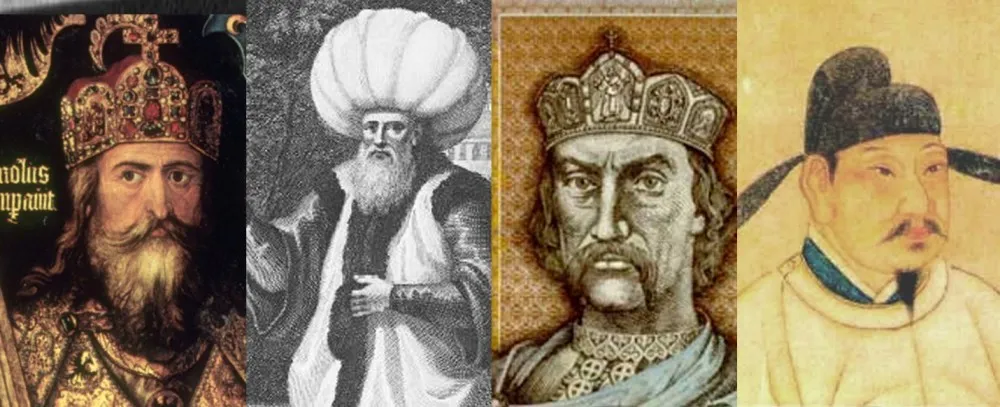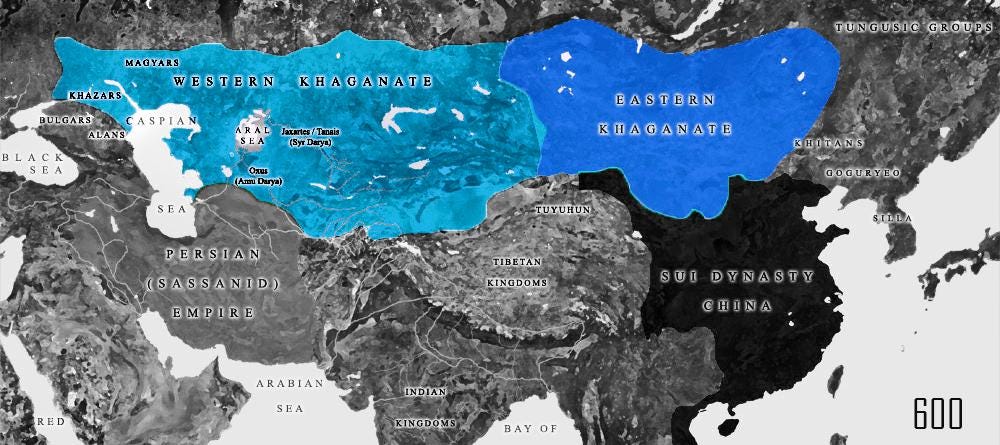Why the Jews of Khazaria, the Himyarites and GokTurk Empire Are Keys to Universal History
TRANSCEND MEMBERS, 23 Oct 2023
Matthew Ehret Insights – TRANSCEND Media Service
18 Oct 2023 – With the fires of potential global war once again erupting across the Middle East, and with obvious anti-Jewish rage amplifying to an extreme degree, I would like to take a moment to follow up on a previous essay titled ‘The Peace of Westphalia as a Lesson in Solving Religious Wars Past Present or Future’.
The purpose of this investigation into the deep structure historical dynamics shaping our present world is not to simply romanticize bygone ages but to help clarify the principled dynamics that feudalistic oligarchs have been obsessively trying to destroy over the course of the past two millennia. I here refer to the dangerous outbreak of peace through cooperation that has tended to occur between religious rivals in never-ending wars across the ages.
In this location, I would like to go a little deeper into the longer wave of history shaping our presently confused age by taking a look at the Jewish Kingdom of Khazaria (8-11th century CE).
Taking the time to investigate this important part of world history is additionally important as China’s New Silk Road currently represents the greatest hope for peace amongst various faiths and cultures not only in the Middle East, but globally. This is not the first time that the Silk Road ushered in a hope for a new age of reason amongst diverse cultures and as we shall soon see, the Kingdom of Khazaria played a major role in that endeavor which St Augustine called a City of God well over a millennium ago.

The Mystery of Khazaria in the Modern Era
Typically well informed readers who frequent alternative media either have never heard of the Jewish Khazar Kingdom that dominated central Europe, southern Russia and the Caucuses in the 7-10th century or IF THEY HAVE heard of it, they tend to believe that this Kingdom was the source of everything evil up until modern times. Many mainstream scholars tend to simply deny all evidence that this Jewish kingdom ever even existed.

I would like to take a novel approach to this anomalous matter of Khazaria and the broader role of Judaism in world history. Not only do I assert that bountiful evidence allows us to conclude that this Jewish Kingdom certainly did certainly exist, but all existent evidence points to the fact that it was the very opposite to a hotbed for “evil Ashkenazi Jewry” as so many lazy researchers have claimed. Instead, this report will attempt to prove that the forgotten kingdom was not only a beautiful phenomenon uniting all three major Abrahamic faiths under one ecumenical alliance of cooperation for well over a century, but also served as a keystone to the newly reborn Silk Road trade routes uniting Asia with Europe through the Confucian Tang Dynasty (618-912 CE).

Much of the following report was made possible by the pioneering work of historian Pierre Beaudry in his online book The Charlemagne Ecumenical Principle.
Under a primitive version of Samuel Huntington’s Clash of Civilizations doctrine, the Venetian Empire and the Ultramontane Church which were the heirs of the recently collapsed Roman oligarchy hated the rise of the Carolingian Empire under Charlemagne and the Augustinian humanist educational and economic reforms enacted during Charlemagne’s reign. More importantly, they hated the brilliant alliances Charlemagne oversaw alongside his co-thinker Harun al Rashid (Caliph of the Abassid Dynasty of Baghdad who ruled from 786-809 CE) and the new King Bulan of Khazaria who converted his kingdom to Judaism in the mid-8th century.

Figure 4- Four Great ecumenical leaders (left to right): Charlemagne, Harun al Rashid, King Bulan and Emperor Xuanzong
The Turkish Conversion to Judaism: The China Angle
In 578 AD, the vast GokTurk Empire had extended from Mongolia, through Eurasia, all the way to Crimea in today’s Ukraine. The empire that had arisen only 30 years earlier played a major diplomatic role in mediating relations between the Byzantine Empire (the surviving eastern Roman Empire) and the pre-muslim Sassanid Persian Empire.

Through a series of marriages with leading princesses of the short-lived western Wei dynasty, and Northern Zhou Dynasty of China (in 562 and 568), leading Khagans of the GokTurks became instrumental in facilitating the revival of the old trade routes of the Silk Road corridors that had fallen into disarray with the collapse of the Han Dynasty in 200 AD.
With the death of the fourth ruler (Taspar Khagan) in 586, warring factions vied for control and a civil war broke out resulting in the eventual split of the Empire into an eastern and western division. Before the emergence of the Tang Dynasty in 618, various rival dynasties in China would also be a factor in the disarray that spread across Central and Eastern Asia during these chaotic years.

Khazaria was first established in the mid-7th century by the western Turkish Khaganate that had become independent from any obedience to the eastern Turkish parent empire when the later had been defeated militarily by the Taizong Emperor of the Tang Dynasty of China in 643 CE. With the Western Khaganate’s defeat (the eastern branch had been defeated by Li Jing in 630), only the most western branch of the GokTurks remained with Khazaria.
With this 643 victory, the Chinese Emperor was made “Tengri Khagan” (Heavenly King), supreme authority over all Turks. 100,000 Turks then migrated to China’s vastly expanded realm and 10,000 Turkish elites settled in the capital. Letters from various Turkish leaders to the Tang court all the way until 741 CE continued to recognize China’s emperors as “Heavenly Khagan”.
Confucianism spread electrically across the entire Turkic world and the newly independent Turks of the west quickly established a highly developed centralized government in Khazaria whose economy would be based primarily upon fisheries, and agriculture. Khazaria became a keystone in the Silk Road with primary routes of the Steppe Silk Road going east-west over land from Uygur Territory in the east to western Crimea and export/import lines along the Dnieper, Don and Volga Rivers which fed into the Caspian and Black Seas.
Khazaria also held the vital North-South trade route along the Volga from Scandinavia through Central Russia to Islamic Iran and Azerbaijan. Since Venetian steered-wars with Islam made Mediterranean trade impossible, and also made it unsafe for Christians or Muslim merchants to move through each other’s’ territories, this Khazarian route was vital and the role of Jews indispensable for trade.
Anomalies of Jewish Khazars
The fact that Khazaria was founded by Turks with a strong link to China cannot be ignored. When evaluating this fact, we must hold three important facts in mind:
1) Countless scholars have noted the strong Confucian philosophy embedded in the western Turkish Khaganate that established the Kingdom of Khazaria before King Bulan’s later conversion to Judaism sometime around 750CE. Even though they were shamanistic, the Confucian principle of the Mandate of Heaven was a core belief of the Khazarian turks.
2) The presence of Jews in China at this time was anomalously large with the first recorded influx of Jews occurring in 618 CE with the start of the Tang Dynasty. As the Tang emperor revived the Silk Road trade routes that had fallen apart after the fall of the Han Dynasty in the 200 CE, Buddhists, Hindus, Nestorian Christians, Zoroastrians, Muslims and Jews flocked to China. This was an especially positive breath of fresh air for Jews as Professor Pan Guang stated: “they could preserve their native customs and religious beliefs… In education, work, buying and selling of land, marriage and the right to move, they enjoyed the same rights and treatment as Han Chinese. They never faced discrimination”.
This tolerant Chinese policy stood in stark contrast to the persecution and forced conversions had run rampant across the west. Major prosecutors of violence against Jews at the time was driven by Emperors Heraclius (610-641), Justinian II (685-695), Leo III (717-741) and Romanos I (920-944) of the Byzantine Empire.
Much of this persecution stemmed less from religious reasons and more from geopolitical ones as the earlier Jewish Himyaritic Kingdom’s conversion to Judaism in 380 CE disrupted Byzantine interests to control a vital shipping corridor (the Bab el-Mandeb Strait) into the Red Sea off the coast of today’s Yemen. That’s right, between 380 until 525 AD, a major kingdom occupying all of Yemen and major regions of Saudi Arabia was… Jewish. The surviving accounts of Himyarite Dynasty are as scarce as those of Khazaria, but if the accounts of the Christian Priest Symeon of Beth Arsham who lived in the early 6th century are true, then it appears that a Himyarite leader named Yusuf (Joseph) had launched a coup in 524 followed by a persecution of Christians living in and around Yemen. This attack on Christians (if it was true) resulted in a total war of annihilation of Yusuf and the end to the Himyarite kingdom.
3) The primary group in this early phase of the renewed Silk Road routes were Jewish Radhanite traders originating from the city of Radhan in Iraq. According to Persian scholar al Masudi (896-956), these Jewish traders spoke Arabic, Greek, Persian, Slavic, Spanish and Frankish and according to 9th century geographer Ibn Khurdabhe, there were four Radhanite trade routes linking Europe to China. The primary and most active corridor moving through the Middle East and to Europe was “the Steppe Silk Road” much of which under the jurisdiction of Khazaria.
The Ecumenical Jewish, Christian, Muslim, Confucian Alliance
_____________________________________________________
This article was also presented by the author as a class, as part of the RTF Lecture Series “The Renaissance Principle Across the Ages“.
 Matthew Ehret is a member of the TRANSCEND Network for Peace Development Environment, a journalist, and co-founder of the Rising Tide Foundation. He is the Editor-in-Chief of Canadian Patriot Review, Senior Fellow at the American University of Moscow and host of The Great Game on Rogue News. He has authored the book series The Untold History of Canada and the recently published book series The Clash of the Two Americas. Email: matt.ehret@tutamail.com
Matthew Ehret is a member of the TRANSCEND Network for Peace Development Environment, a journalist, and co-founder of the Rising Tide Foundation. He is the Editor-in-Chief of Canadian Patriot Review, Senior Fellow at the American University of Moscow and host of The Great Game on Rogue News. He has authored the book series The Untold History of Canada and the recently published book series The Clash of the Two Americas. Email: matt.ehret@tutamail.com
Tags: Confucianism, History, Jews, Muslims, Turkey
DISCLAIMER: The statements, views and opinions expressed in pieces republished here are solely those of the authors and do not necessarily represent those of TMS. In accordance with title 17 U.S.C. section 107, this material is distributed without profit to those who have expressed a prior interest in receiving the included information for research and educational purposes. TMS has no affiliation whatsoever with the originator of this article nor is TMS endorsed or sponsored by the originator. “GO TO ORIGINAL” links are provided as a convenience to our readers and allow for verification of authenticity. However, as originating pages are often updated by their originating host sites, the versions posted may not match the versions our readers view when clicking the “GO TO ORIGINAL” links. This site contains copyrighted material the use of which has not always been specifically authorized by the copyright owner. We are making such material available in our efforts to advance understanding of environmental, political, human rights, economic, democracy, scientific, and social justice issues, etc. We believe this constitutes a ‘fair use’ of any such copyrighted material as provided for in section 107 of the US Copyright Law. In accordance with Title 17 U.S.C. Section 107, the material on this site is distributed without profit to those who have expressed a prior interest in receiving the included information for research and educational purposes. For more information go to: http://www.law.cornell.edu/uscode/17/107.shtml. If you wish to use copyrighted material from this site for purposes of your own that go beyond ‘fair use’, you must obtain permission from the copyright owner.